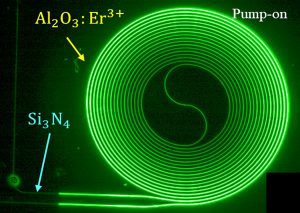[University of Twente] – A new light amplifier, developed at the University of Twente, not only boosts up the light signals on a photonic chip, it also enhances the applicability of those chips. Thanks to stronger light signals, an autonomously driving car will be better capable of scanning its surroundings. One of the major advantages of the new amplifier is its small size. For preparing this concept for market introduction, Professor Sonia Garcia Blanco – an adjunct professor in the Optical Sciences Group, part of the MESA+ Institute of the University of Twente – received a Proof of Concept grant of the European Research Council
Photonic integrated circuits (PIC’s) are being introduced in a growing number of application areas: we all know the chips on which many electronic components are integrated, but in the case of a PIC, the components process light signals. PIC’s can be found e.g. in datacenters and 5G signal processing. And the autonomous cars of the future heavily depend on photonics: using the LIDAR (light detection and ranging) technique.
The stronger the output signal, the better the car will be able to correctly evaluate its surroundings. Just like in electronics, optical amplifiers boost up optical signals. However, in the case of photonics, amplifiers are not often integrated onto the same chip and thus need to be connected separately – which can make the system lossy and vulnerable. Sonia Garcia Blanco and her team now developed an amplifier that overcomes these disadvantages. It makes use of the combination of aluminum oxide and erbium, and an innovative coupling technique.
Double layer
Erbium is often used in fiber optical amplifiers (EDFA’s), but this mostly results in bulky components. Thanks to the correct combination of material, erbium concentration and waveguide architecture, the amplifier can be made very small, while providing high optical gain. A major question is: how do you connect the amplifier with the rest of the photonic circuit? Th
is is achieved by using a double photonic layer coupler technology developed in Garcia-Blanco’s group. A special ‘tapering’ design permits transferring the light back and forth between the passive silicon nitride photonic circuit and the amplifier section, with negligible loss. In this way, the amplifier section becomes a building block that can be introduced by chip designers into any photonic chip that requires amplification. It resembles the way electronic building blocks can be introduced on every part of an electronic chip. Garcia Blanco: “Our optical gain building block addresses the current problems of performance, scalability and flexibility.”
The amplifier is one of the results of the ‘Rare-earth doped novel on-chip sources’ project, for which Sonia Garcia Blanco obtained a ‘Consolidator Grant’ of the European Research Council in 2015. This is now followed up by a ‘Proof of Concept’ grant enabling her to take accelerate the market readiness of the new concept.






